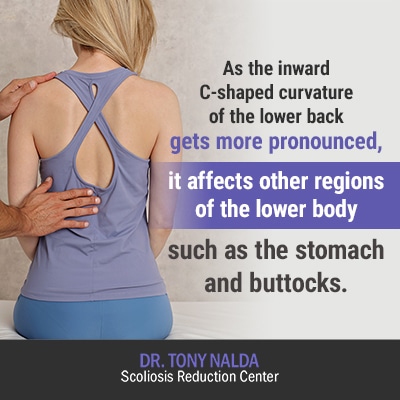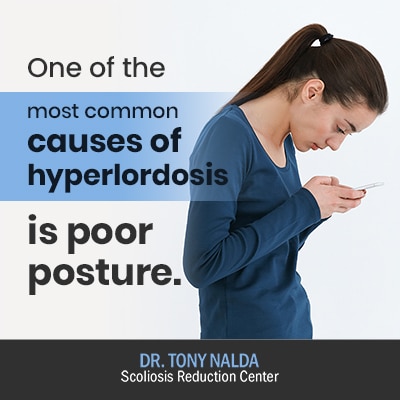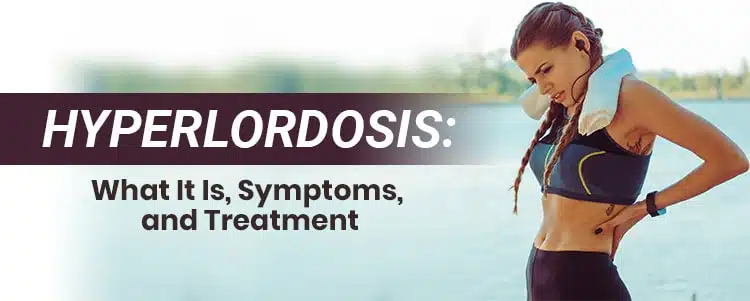As a chiropractor focusing on scoliosis treatment, I have treated many different spinal conditions, hyperlordosis being one of them. When a patient has an over-pronounced curvature of the lumbar spine, I can work to restore the healthy spinal curvature and work towards improving the spine’s overall health and function.
The spine’s natural curvatures give it added strength, flexibility, and help to distribute the mechanical stress that’s incurred during movement. The spine’s overall function and health are dependent upon these healthy curvatures. If the lower back becomes excessively curved, this is known as ‘hyperlordosis’.
Before we delve into potential symptoms of and treatment for hyperlordosis, let’s first explore some basic spinal anatomy, the role of the spine’s natural curvatures, and what happens to the spine as hyperlordosis develops.
4 Key Takeaways
- Understanding Sciatica and Its Causes: Sciatica is caused by irritation of the sciatic nerve, with common culprits being herniated discs, bone spurs, and spinal stenosis. Recognizing the root causes is crucial for targeted treatment.
- Identifying Symptoms of Sciatica: Symptoms range from mild ache to a sharp, burning sensation, predominantly radiating from the lower back down through the legs. Early recognition of these signs can lead to more effective management strategies.
- Effective Stretches for Sciatica Relief: Incorporating stretches like the Scissor Hamstring Stretch and Sciatic Nerve Glide into daily routines can significantly alleviate pain by improving flexibility and reducing nerve irritation.
- Comprehensive Approach to Sciatica Treatment: A holistic treatment plan that includes posture correction, physical activity, and professional guidance addresses both symptoms and underlying causes for long-term relief.
How and Why the Spine is Curved
If you were to look at a healthy spine from the side, you would see that it has a soft ‘S’ shape. Just as there are three main sections to the human spine, there are also three main corresponding curvatures that characterize each section.
As mentioned, the spine’s natural and healthy curvatures give the spine its strength, flexibility, and enable it to distribute the stress caused by movement evenly throughout. When one or more of the spine’s natural curvatures are lost, its effects can be felt throughout the spine.
The cervical spine includes the upper back and neck and has a C-shaped curve that bends inward towards the body’s center.
The thoracic spine refers to the middle back and has a reverse C-shaped curve that bends outwards, away from the body’s center.
The lumbar spine includes the lower back and also has a C-shaped curvature, like the cervical spine. Normal lumbar lordosis, characterized by a specific lumbosacral angle, plays a critical role in spinal stability and biomechanics, particularly during pregnancy.
The spinal curvatures that bend inwards in a typical C-shape are known as ‘lordosis’, and the curvatures that bend outwards in a reverse C-shape are known as ‘kyphosis’.
When the spine has an over-pronounced reverse C-shaped curve, this is known as ‘hyperkyphosis’, and when the spine has an over-pronounced C-shaped curve, this is known as ‘hyperlordosis’.
Let’s move on to specifically addressing hyperlordosis.
Understanding Hyperlordosis
When it comes to understanding hyperlordosis (ICD code: M40.56), keep in mind what we discussed earlier: the roles of the spine’s healthy curvatures.
When a person develops hyperlordosis, its effects can be felt throughout the spine as it throws off its overall biomechanics. The condition is characterised by an exaggerated inward curvature that occurs along the lumbar spine; it is also called ‘swayback’ or ‘saddleback’.
The condition can occur at any age, but is rare in children.

As the inward C-shaped curvature of the lower back gets more pronounced, it affects other regions of the lower body such as the stomach and buttocks. Anterior pelvic tilt can exacerbate hyperlordosis and should be avoided during exercises to prevent worsening of posture problems and lower back pain.
This leads us into discussing the symptoms of hyperlordosis.
Characteristics of Hyperlordosis
Hyperlordosis is characterized by an excessive inward curvature of the lumbar spine, often referred to as “swayback” or “saddleback.” This pronounced curvature can lead to a variety of symptoms, including lower back pain, limited mobility, and a protruding stomach.
While hyperlordosis can occur at any age, it is rare in children. The condition not only affects the lumbar spine but can also impact other regions of the lower body, such as the stomach and buttocks, leading to a noticeable change in posture. Understanding these characteristics is crucial for recognizing and addressing the condition early on.
What are Common Symptoms of Hyperlordosis?
When a person has an over-pronounced lordosis of the lumbar spine, this is diagnosed as hyperlordosis. Common symptoms can include lower back and/or neck pain, limited movement, a protruding stomach, and buttocks that are pushed outwards.
Tight muscles can contribute to lower back pain and limited movement in hyperlordosis.
An important factor to keep in mind, however, is that when it comes to spinal conditions, they can produce a myriad of symptoms of varying degrees that affect people differently.
Variables such as age and spinal flexibility play significant roles in whether or not patients will experience the aforementioned symptoms, and to what extent.
The degree of condition severity also plays a significant role in determining just how noticeable the condition’s postural changes are, as well as experienced symptoms. In mild hyperlordosis, the spine can stay relatively flexible, making it less likely to cause pain or mobility restrictions.
In cases where the exaggerated curvature is severe, there is a higher likelihood of developing adverse symptoms such as back and/or neck pain and noticeable postural changes.
Now that we’ve defined hyperlordosis and touched on the effects it can have on the body and common symptoms, let’s move on to what causes its development in the first place.
What Causes Hyperlordosis? Excessive Anterior Pelvic Tilt
There are multiple variables that could cause, or contribute to, the development of hyperlordosis. From poor posture, obesity and a sedentary lifestyle, to the presence of an underlying spinal condition, the root cause of hyperlordosis can be a number of factors.
Poor Posture

One of the most common causes of hyperlordosis is poor posture. Poor posture affects the body in a number of ways, and as one of the roles of the spine is to help us maintain straight and upright posture, it makes sense that chronic bad posture could greatly impact spinal health.
When a person spends a lot of time sitting, especially when they are not sitting upright with the shoulders back and the spine straight, the muscles closely attached to the lumbar spine can become excessively tight as they try to support and stabilize the spine. Weak muscles can also result from poor posture, contributing to the development of hyperlordosis.
Over time, this can pull the spine out of alignment and lead to an increase in the lumbar spine’s inward curvature.
This is why it’s so important to maintain good posture while sitting and to take frequent movement breaks to minimize the strain on the muscles of the lower back.
Obesity
When a person is overweight and carries excess fat in the buttocks and abdomen areas, this puts extra strain on the lumbar spine and the muscles charged with supporting and stabilizing it.
The extra strain on the lumbar spine can cause it to bend unnaturally and develop an exaggerated lordosis.
Sedentary Lifestyle
The spine’s very design is to facilitate movement, so living a sedentary lifestyle with a lack of exercise is contrary to the spine’s structure and function.
In addition to the fact that lack of exercise is likely to lead to obesity, a sedentary lifestyle also weakens the body’s core muscles that surround the trunk and pelvis.
When the body’s core muscles are weakened due to lack of use, they are less capable of providing adequate support and stabilization for the spinal column, and this makes the lumbar spine particularly vulnerable to developing an excessive curvature. Strengthening the abdominal muscles is crucial to support the spine and prevent conditions like hyperlordosis.
Underlying Spinal Conditions
As such an important part of human anatomy, the spine can develop a number of conditions. In some cases, a person can develop hyperlordosis as a result of another underlying spinal condition.
Spinal conditions that are commonly linked to the development of hyperlordosis include kyphosis, discitis, and spondylolisthesis.
The spine has a complex structure with many important parts and functions. When a spinal condition develops, it can affect more than just one area of the spine as the spine’s curvatures are dependent upon one another.
Kyphosis
If the thoracic spine has an exaggerated kyphosis (outward curvature), this can throw off the spine’s entire alignment and cause a counteractive curvature to develop, such as hyperlordosis in the spinal section below.
Generally speaking, when the spine loses one or more of its healthy curves, the body responds by putting in bad curves, so one abnormal curvature can lead to a loss of more healthy curvatures as they are replaced by unnatural curves.
Discitis
Discitis is a disease that can be caused by a viral or bacterial infection of the intervertebral discs.
The intervertebral discs sit between adjacent vertebrae (bones of the spine) and provide cushioning, protection, help hold the parts of the spine together, and act as the body’s shock absorbers.
When the intervertebral discs develop an infection, their health is compromised, as is the health of the entire spine. When the discs are unhealthy, the spine’s support and structure is compromised, making it vulnerable to misalignment and the development of abnormal spinal curvatures.
Spondylolisthesis
Spondylolisthesis is a spinal condition of the lower spine. It is a disease that causes one of the lumbar spine’s vertebrae to slip forward onto the vertebra below it. As the two vertebrae start rubbing up against one another, this extra pressure erodes the disc and vertebrae affected, making the spine unstable and more prone to becoming misaligned.
Now that we have defined hyperlordosis, talked about its common symptoms and causes, let’s move on to the important topic of treatment.
How Do You Treat Hyperlordosis?
To treat hyperlordosis, the approach will be determined by the condition’s underlying cause. For the most common causes of hyperlordosis, treatment will involve addressing relevant postural and lifestyle issues. When hyperlordosis is caused by another underlying spinal condition, the primary condition will be the guiding force of treatment.
Here at the Scoliosis Reduction Center®, we conduct ourselves based on the belief that the treatment focus should be on the underlying condition, not on symptoms of the condition.
Too often, especially in traditional general medicine, the focus is on addressing a condition’s symptoms, rather than addressing their underlying cause, which is the condition itself.
This is an important distinction to understand because it can mean the difference between relying on medication to live with symptoms, or treating the condition causing the symptoms in a proactive way that can permanently lessen or alleviate them, rather than masking them with prescription pain medications.
For cases caused by poor posture and obesity, we provide guidance on how to correct the bad habits contributing to the lower-back condition; that way, we are addressing the condition’s underlying cause, and as that is done, related symptoms such as pain and/or postural changes are addressed throughout treatment.
A big part of treating spinal conditions caused by obesity and/or living a sedentary lifestyle is to provide guidance for patients on the best exercises to do that are specific to their condition.
In the context of hyperlordosis, this might include the introduction of lumbar-stabilization exercises known to improve lumbar muscle strength, flexibility, and decrease the load on the spine.
When hyperlordosis is caused by the presence of another underlying spinal condition, the primary driving force of treatment is addressing the spinal condition that contributed to the development of hyperlordosis.
When it’s caused by kyphosis elsewhere along the spine, as we work towards restoring that abnormal curvature, the spine’s overall biomechanics are improved upon, as well as any other counteractive curvatures that have developed along the upper and/or lower spine.
If the hyperlordosis is caused by a condition of the intervertebral discs, then the health of the discs have to be restored, and as that happens, the misalignment that developed from the lack of stability can be gradually improved upon.
When spondylolisthesis is the cause of hyperlordosis, we work towards restoring the spine’s alignment; we can do this with corrective bracing, scoliosis-specific chiropractic adjustments, therapy and rehabilitation.
Our approach is integrative, which lends itself easily to customizing treatment plans by combining multiple treatment disciplines to address the unique characteristics of every patient and their condition.
Of course, the best medicine is always prevention, when possible. Being armed with awareness and knowledge of how certain habits can help lower the likelihood of developing certain conditions is invaluable.
Physical Therapy Management
Physical therapy plays a pivotal role in managing hyperlordosis. A skilled physical therapist can develop a personalized exercise program tailored to strengthen the muscles surrounding the spine, improve posture, and alleviate symptoms. The primary goals of physical therapy are to enhance spinal alignment, reduce pain and discomfort, and boost overall mobility. By focusing on exercises that target the core and lumbar region, physical therapy helps in stabilizing the spine and mitigating the effects of hyperlordosis. This proactive approach not only addresses the symptoms but also works towards correcting the underlying issues contributing to the condition, but this is a limited approach still.
Clinical Considerations
When diagnosing and treating hyperlordosis, it is essential to consider the underlying cause of the condition. Factors such as poor posture, obesity, and other underlying spinal problems can all contribute to the development of hyperlordosis. A thorough medical history and physical examination are necessary to pinpoint the root cause. In some cases, imaging studies like X-rays or MRI scans may be required to confirm the diagnosis and assess the severity of the curvature. Treatment plans are then tailored based on the identified cause, ensuring a comprehensive approach that addresses both the symptoms and the underlying issues. This holistic method is crucial for effective management and long-term relief from hyperlordosis.
Prevention and Hyperlordosis
When it comes to preventing the onset of hyperlordosis, considering the most common causes – poor posture, obesity, and lack of exercise – these are often lifestyle choices that can be made differently.
The spine’s very design is about movement, so living a life in contrast to that is bound to have negative effects on the spine’s overall health.
When hyperlordosis is caused by the presence of another spinal condition, whether or not it’s preventable will depend on the nature of the more dominant spinal condition.
Generally speaking, when it comes to preserving the health of the spine and trying to stave off the degenerative effects that can accompany aging, staying mobile and active is the best preventative measure as it keeps the spine and its surrounding muscles as loose and flexible as possible.
Movement is also the means by which the intervertebral discs replenish themselves and maintain their fluid levels. Without their own vascular supply, movement is an essential part of preserving the health and function of the spine’s discs. Drinking lots of water can also help preserve the discs.
In addition, doing exercise that engages the core also helps keep the muscles that support the working in optimal order, meaning the spine can be adequately supported and stabilized.
The spine is a complex network of bones, facets, ligaments, and intervertebral discs. If a condition develops that affects any one of these parts, its effects can be felt throughout the spine and in multiple areas of the body.
While it’s natural for the spine to have curvatures, if a curvature becomes too under- or over-pronounced, this can lead to problems such as a misalignment of the spine.
When the lumbar spine’s C-shaped curvature becomes exaggerated, this means there is a loss of the lumbar spine’s healthy and natural curvature.
Depending on the severity of the hyperlordosis, as well as the cause, this can produce symptoms such as lower-back pain, postural changes, and limited movement.
Common causes of hyperlordosis include poor posture, obesity, lack of exercise, and the presence of other spinal conditions such as kyphosis, discitis, and spondylolisthesis.
Fortunately, for the more common causes of hyperlordosis (poor posture, obesity, and lack of exercise), these can be addressed with guidance on specific lumbar-stabilization exercises and the reversal of bad-lifestyle habits.
When hyperlordosis is caused by an underlying spinal condition, we let the underlying condition be the guiding force of our treatment as in these types of cases, the hyperlordosis is a symptom of the more dominant spinal condition.
The bottom line is regardless of the cause or severity of your hyperlordosis, it’s never too late to start treatment and work towards an improvement.





